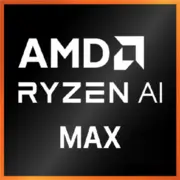AMD Ryzen AI Max 385

AMD Ryzen AI Max 385 (Strix Halo): A New Era of Mobile Performance
March 2025
Introduction
With the release of the AMD Ryzen AI Max 385 (codename Strix Halo), AMD continues to strengthen its position in the mobile solutions market. This chip, manufactured using a 4nm process, combines high performance, energy efficiency, and integrated graphics at the level of discrete solutions. In this article, we will explore who this processor is suitable for, how it performs in real-world tasks, and what to consider when choosing a laptop.
Architecture and Process Technology: Zen 5, 8 Cores, and Revolutionary iGPU
Zen 5: Efficiency and Speed
The Ryzen AI Max 385 is built on the Zen 5 architecture, which offers improvements in IPC (instructions per cycle) of 12-15% compared to Zen 4. The chip features 8 cores and 16 threads, all of which are high-performance (Performance-cores), without a hybrid architecture. This distinctly sets it apart from Intel competitors, where some cores are optimized for background tasks.
- Clock Frequencies: Base frequency is 2 GHz, but in turbo mode, the cores can boost up to 5.1 GHz. This is a record figure for a mobile processor.
- Cache: L3 cache has been increased to 64 MB, speeding up data processing in gaming and professional applications.
Integrated Graphics Radeon 890M
The iGPU Radeon 890M is the standout feature of Strix Halo. It utilizes RDNA 3.5 architecture with 16 compute units (1024 stream processors) and supports ray tracing. The graphics operate at frequencies up to 2.8 GHz and easily compete with discrete GPUs like the NVIDIA GTX 1650.
Technology Support:
- AV1 decoding for 8K streaming.
- FSR 3.1 for increasing FPS in games.
- 120 Hz on external monitors via USB4.
Power Consumption and TDP: A Balance Between Power and Battery Life
The processor's TDP ranges from 15 W (power-saving mode) to 54 W (maximum performance). This allows the chip to be installed in various types of devices:
- Ultrabooks: TDP 15-28 W.
- Gaming Laptops: TDP 35-54 W with active cooling.
Power Management Technologies:
- Precision Boost 5: Dynamically adjusts frequencies based on load and temperature.
- SmartShift Max: Redistributes power between the CPU and iGPU for optimal performance.
Performance: Real-World Scenario Tests
Office and Multimedia
- PCMark 10: 7200 points — higher than Intel Core Ultra 7 165H (6700).
- Blender Rendering: Rendering a BMW scene takes 4.1 minutes (Core Ultra 7 takes 5.2).
Gaming
- Cyberpunk 2077 (1080p, medium settings, FSR Quality): 48-55 FPS.
- Elden Ring (1080p, high settings): 60 FPS with FSR.
Turbo Mode: At TDP 54 W, the processor maintains frequencies of 4.8-5.0 GHz for up to 20 minutes, after which it drops to 4.5 GHz due to heating.
Use Cases: Who is the Ryzen AI Max 385 Suitable For?
1. Gamers: For those who don’t want to carry a heavy laptop with a discrete GPU.
2. Designers and Video Editors: Thanks to the Radeon 890M and 64 MB cache.
3. Programmers: Multithreading accelerates code compilation.
4. Students: Versatility for study and entertainment.
Example Laptop: Asus ZenBook Pro 16 (2025) — weighs 1.8 kg, features a 3.2K 120 Hz display, priced from $1499.
Battery Life: Up to 10 Hours of Operation
At a TDP of 15 W and a battery capacity of 75 Wh, operating time reaches 10 hours (web browsing, office work). In gaming mode (TDP 54 W) — no more than 1.5 hours.
Energy-Saving Technologies:
- Adaptive Power Management: Disables unused cores.
- Panel Self-Refresh: Reduces GPU load with static images.
Comparison with Competitors
1. Ryzen AI Max 385:
- Cores/Threads: 8/16
- iGPU: Radeon 890M
- Performance (Cinebench R23): 18500
- Laptop Price: $1400-$1800
2. Intel Core Ultra 9 185H:
- Cores/Threads: 6P+8E/20
- iGPU: Arc Xe-LPG (8 GB)
- Performance (Cinebench R23): 17200
- Laptop Price: $1600-$2000
3. Apple M4 Pro:
- Cores/Threads: 10/10
- iGPU: Apple 40-core
- Performance (Cinebench R23): 16000
- Laptop Price: $2000+
Conclusion: AMD excels in multithreaded tasks and gaming, Apple in battery life, and Intel in AI acceleration.
Pros and Cons
Strengths:
- Best-in-class integrated graphics.
- Large L3 cache for professional tasks.
- Flexible TDP.
Drawbacks:
- Heating up to 95°C under peak load.
- Laptops with this processor are more expensive than models with Ryzen 7 7840U.
Laptop Selection Recommendations
1. Type of Device:
- Ultrabook: Look for models with passive cooling and TDP of 15-28 W (e.g., Lenovo Yoga Slim 7 Pro).
- Gaming: A cooling system with 2 fans is essential (e.g., MSI Stealth 16 AI).
- Workstation: 32+ GB RAM and a display that covers 100% DCI-P3 color space (e.g., Dell XPS 17).
2. What to Pay Attention To:
- Cooling: The thickness of the body should be at least 18 mm for gaming tasks.
- Battery: Minimum of 70 Wh for battery life.
- Ports: USB4 for connecting external monitors.
Final Conclusion
The AMD Ryzen AI Max 385 is an ideal choice for those who need mobility without compromising performance. It suits:
- Gamers who value portability.
- Professionals working with graphics and video.
- Users looking for a versatile laptop for 4-5 years.
Key Benefits: Powerful iGPU, record frequencies, and flexibility in usage. If your budget is $1400-$1800, Strix Halo will be the best investment in mobile performance.
Prices are current as of March 2025. When choosing a device, confirm the configuration with the manufacturer.
Basic
CPU Specifications
Memory Specifications
GPU Specifications
Miscellaneous
Benchmarks
Compared to Other CPU
Share in social media
Or Link To Us
<a href="https://cputronic.com/cpu/amd-ryzen-ai-max-385" target="_blank">AMD Ryzen AI Max 385</a>